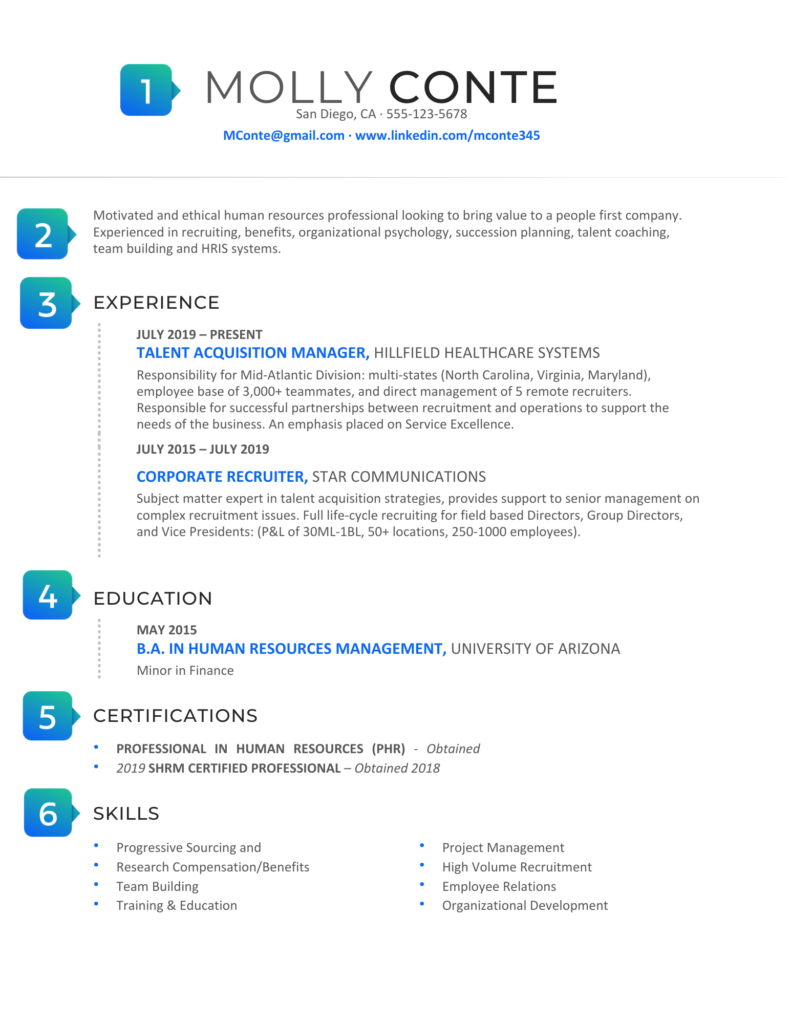
If you’ve been a diligent member of the workforce for several years, you’ve built up a substantial list of specialized skills that are highly relevant to your line of work. You’ve also achieved some noteworthy accomplishments to the benefit of your managers and employer. Your mid-career resume is the place to showcase these skills and accomplishments.
What to Focus on in a Mid-Career Resume
Specialized skills
At this point in your career, you should have a pretty long list of technical and soft skills to your name. The ones that earn a spot on your resume should go beyond the basics, which are a given if you’ve moved beyond an entry-level job. If you’re a mid-level accountant, for example, noting your skills in advanced accounting concepts like intercompany transactions and trusts is going to be more impressive than listing QuickBooks.
Quantifiable achievements
Show how you’ve made an impact in your current and previous roles, using numbers and supporting details as much as possible. Dollar figures, growth percentages, time spans and volume are all good ways to quantify your achievements, i.e. ‘increased customer satisfaction ratings by 46% over a 12-month period.’
Career progression
When you have a few years of work under your belt, demonstrating career advancement on your resume is more important than documenting every single job you’ve ever held. Your positions and the descriptions you include for each of them should convey increasing levels of responsibility and leadership roles where applicable.
Why Do You Need a Mid-Career Resume?
Hiring managers are more discerning when assessing mid-level candidates than they might be when considering entry-level candidates who are still learning the ropes. At this stage, employers are looking for candidates with a proven track record of making meaningful contributions in their roles. You need a resume to showcase these contributions.
A mid-level resume is also necessary to differentiate yourself from other candidates with similar job titles and years of experience. How do you stand out? Why should a hiring manager choose you over the other applicants? Your resume should answer these questions and entice them to schedule an interview to learn more.
When Should You Use a Mid-Career Resume?
Use a mid-career resume when:
- Applying for a job at a new company
- Seeking a lateral move or promotion within your company
- Changing careers
Common Mid-Career Resume Challenges and How to Overcome Them
Setting yourself apart from other candidates
While no two professionals are alike, they can appear pretty darn similar when you’re comparing them on paper. To help your resume stand out, avoid cliche words and phrases that are overused by job seekers–‘dynamic’, ‘innovative’, and ‘team player,’ to name a few. Instead, use more descriptive language that captures your actual contributions.
For example, instead of being ‘responsible for’ an activity, maybe you ‘overhauled’ a process or ‘pioneered’ a new initiative. Focus on the results you achieved and quantify your accomplishments whenever possible using specific figures, as we mentioned earlier.
Accurately capturing your career trajectory
One of the most important objectives of a mid-level resume is to show upward career progression. If you’re struggling to make it clear how you’ve grown and advanced, take a closer look at the descriptions listed under each job you’ve held. They should show increasing levels of responsibility–taking the lead on projects, dealing with clients, training or managing other employees, and so on.
At this point in your career, it might also be time to expand your resume from one to two pages to accurately capture your path.
Demonstrating experience when you’re changing careers
Creating a resume when you’re changing careers can present a catch-22. You need relevant experience to get a job in the new industry, but you need to work in the industry to gain relevant experience. Instead of trying to concoct experience you simply don’t have, connect your actual skills–perhaps from unrelated experiences–to the ones the job description calls for.
Maybe you want to move into a project management role. While you may not have had any duties with this exact title in the past, there are lots of different activities that require related skills. Helping plan a team event, coordinating different people’s schedules or even heading up a volunteer group can all be positioned as relevant experience for a project management role.
Find ways to connect the experience you do have to the requirements of the role, using exact words and phrases from the job description, to help hiring managers see your potential.
Mid-Career Resume Format and Key Components
A chronological resume format is a good choice for mid-career professionals since it helps hiring managers clearly see your progression from one job to the next.

Here are the components to include on a mid-level resume:
- Contact information
Include the basics: your name, phone number, address, and email address. Your LinkedIn profile, website, or online portfolio can be added here, as well. If you have any credentials like an MBA, put them after your name so they’re immediately visible. These titles quickly tell hiring managers you have the qualifications associated with the credentials. - Professional summary or objective
This should be highly customized and specific to both your skills and the types of roles you’re seeking. Here’s an example: ‘Technology-driven sales leader seeking a management position in a real estate firm where I can leverage my creativity and negotiation skills to exceed targets.’ - Experience
The experience section is the main substance of a mid-career resume. You want it to wow hiring managers, so don’t rush through it. Spend time carefully strategizing the best way to position each job you’ve held depending on who will be reading the resume. If the companies you’ve worked at are not household names, consider adding a short blurb alongside each one that describes them, i.e. ‘The Flamingo Group – Commercial real estate development serving the hospitality field.’ - Education
Once you have a few years of experience in the workforce, your education can move to the bottom of the resume, the exception being if you have an especially impressive or lengthy academic career. - Certifications (if applicable)
Use this opportunity to list any relevant certifications you have for the position you are applying for. - Skills
These usually take the form of a bulleted list and include your strongest, most relevant skills. They’re sometimes grouped at the top of a resume with the objective statement.
Related: The Best Resume Guide to Get You In the Door


